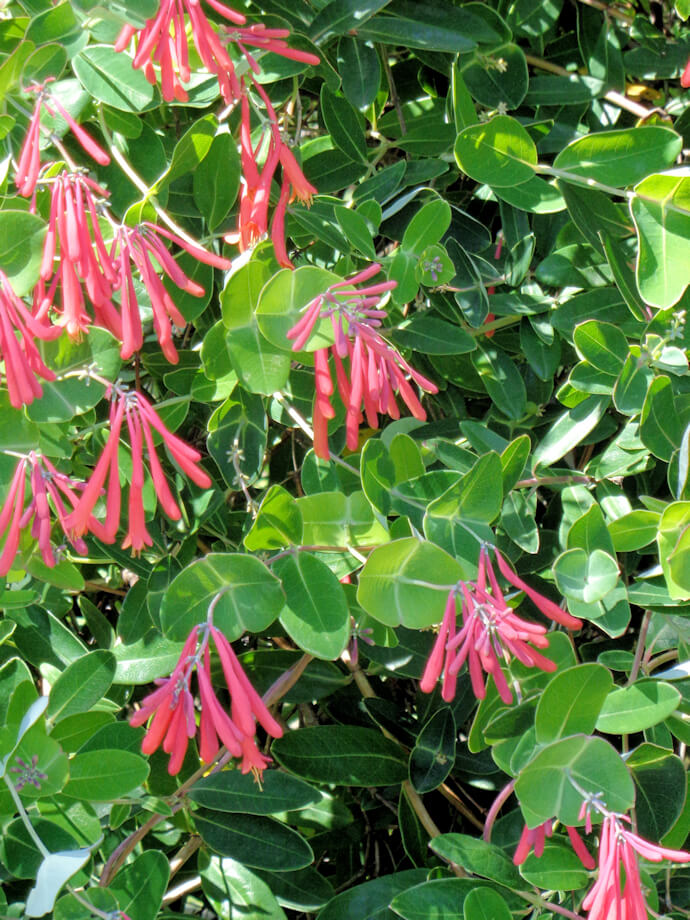
During one of my recent photo safaris to the Nature Park in Punta Gorda, the coral honeysuckle vine display took center stage attention with a wall of flowers. Vines like the coral honeysuckle take your landscape into the next dimension of vertical possibilities as they cover fences and walls, arbors and trellises. This plant material offers flowers and foliage that can create a privacy area, provide shade or even accent architectural subjects.
Vines ‘hang-on” in different ways. Some vines are “clingers”, while others are “twiners”. Clingers include vines such as English ivy, climbing figs and split-leaf philodendrons, which use roots or adhesive disks to attach to rough surfaces. These vines often cling to trees, fences and walls. These types of vines should not be grown on wooden walls because they keep the area moist and may enhance the chance of decay. Another disadvantage of clinger vines is that they can loosen mortar between bricks or concrete blocks and are in general difficult to remove from walls. Another type of clinging vine uses small coiled appendages called tendrils to wind themselves around something in response to friction. The Passion Vine and the Cross Vine are good examples of tendril clingers.
Twiners like to grow on poles, wires or lattice. These vines encircle upright supports and will spiral in one direction only – don’t try to force them the other way! Examples of twiners include Confederate jasmine, mandevilla, and allamanda.
One final classification of vines is called sprawling or clambering vines. These are really just shrubs with very long, thin branches that need to be tied to supports. As these limber branches become older and woody, they will usually support themselves. When you think of a sprawling vine, think of Bougainvillea. Keep in mind these vine differences when selecting a support system.
The proper use of vines includes providing sturdy support. Keep in mind the ultimate function of your vines whether they are used for screening, color or hummingbird attractors. Vines can be grown on arbors or as living walls for privacy. Some gardeners use vines to cover posts, poles or even unwanted trees. Whatever the support, make sure that it is structurally sound, attractive and suitable for the vines you choose.
Make an attempt to select vines that are hardy for our area. While some marginal types may experience cold damage, many will re-sprout in the spring and grow back like new. Some vines that seem to do fine in our area include a variety of passion flowers, Queen’s Wreath, bleeding heart vine, yellow allamanda, bougainvillea, Sky Vine, and coral honeysuckle; just to name a few.
Pruning is the final important item of concern. A very vigorous vine growing up a wall may need to be pruned to keep it off the roof where shingles may be damaged. Some vines may need to be pruned just to keep them neat in appearance, in bounds, and on their support. Vines that are annual bloomers should be pruned right after they bloom. Pruning these vines too late may cut off next year’s buds, while pruning too early may jeopardize this year’s flowers.
Vines will complete your landscape and add an element of beauty that no other plant material can. As with all plants, plan before you plant for a balanced and healthy yard. For more information on all types of vine, or to ask a question, please visit https://www.facebook.com/CharlotteMGLifeline/ . Ralph E. Mitchell is the Director/Horticulture Agent for the UF/IFAS Charlotte County Extension Service. He can be reached at 941-764-4344 or ralph.mitchell@charlottecountyfl.gov.
Resource:
Brown, S. P. & Knox, G. W. (2016) Flowering Vines for Florida, The University of Florida Cooperative Extension Service, IFAS.
 1
1
